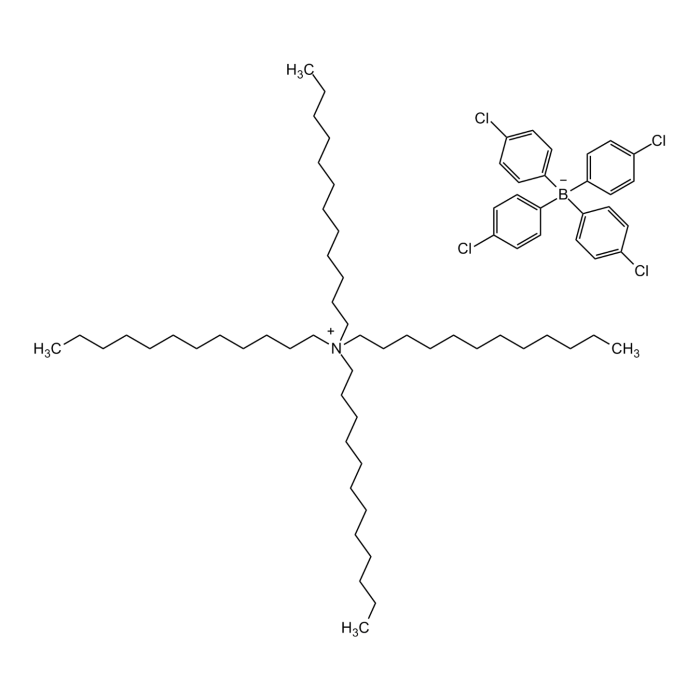Cookie Policy: This site uses cookies to improve your experience. You can find out more about our use of cookies in our Privacy Policy. By continuing to browse this site you agree to our use of cookies.
Chemodex
Tetradodecylammonium tetrakis (4-chlorophenyl)borate

| Product Details | |
|---|---|
| Synonyms | ETH500; TDATpClPB; Tetrakis(4-chlorophenyl)borate tetradodecylammonium salt; BRN 8894894 |
| Product Type | Chemical |
| Properties | |
| Formula | C72H116BCl4N |
| MW | 1148.32 |
| CAS | 100581-42-8 |
| Source/Host Chemicals | Synthetic. |
| Purity Chemicals | ≥95% (NMR) |
| Appearance | White to off-white powder. |
| Solubility | Soluble in dichloromethane or chloroform. |
| Identity | Determined by 1H-NMR. |
| Declaration | Manufactured by Chemodex. |
| Other Product Data |
Click here for Original Manufacturer Product Datasheet |
| InChi Key | OKKRVCFTMNLHTL-UHFFFAOYSA-N |
| Smiles | CCCCCCCCCCCC[N+](CCCCCCCCCCCC)(CCCCCCCCCCCC)CCCCCCCCCCCC.ClC1=CC=C([B-](C2=CC=C(Cl)C=C2)(C3=CC=C(Cl)C=C3)C4=CC=C(Cl)C=C4)C=C1 |
| Shipping and Handling | |
| Shipping | AMBIENT |
| Short Term Storage | +4°C |
| Long Term Storage | -20°C |
| Handling Advice | Protect from light and moisture. |
| Use/Stability | Stable for at least 2 years after receipt when stored at -20°C. |
| Documents | |
| Product Specification Sheet | |
| Datasheet |
 Download PDF Download PDF |
ETH 500 is a lipophilic electrolyte mostly used as an anionic additive for membranes of neutral carrier-based ion-selective macroelectrodes or in membranes of optodes. ETH 500 is a reagents for electrochemistry and can be used to prepare sensor membranes for ion-selective and optical devices. The lipophilic inert electrolyte ETH 500 is incorporated into the membranes of ion-selective electrodes (ISEs) to improve the detection limit and selectivity of the electrodes and decrease the resistance of the sensing membrane. It was shown to enhance remarkably sensors selectivity towards divalent ions, e.g. calcium and magnesium and carbonate.
[1] D. Ammann, et al.; Anal. Chim. Acta 171, 119 (1985) | [2] B.K. Oh, et al.; Anal. Chem. 68, 503 (1996) | [3] S. Jadhav & E. Bakker; Anal. Chem. 71, 3657 (1999) | [4] S. Amemiya & A.J. Bard; Anal. Chem. 72, 4940 (2000) | [5] A. Legin, et al.; Electrochim. Acta 49, 5203 (2004) | [6] J.M. Zook, et al.; Sens. Actuators B Chem. 136, 410 (2009) | [7] M. Sohail, et al.; Anal. Chim. Acta 744, 39 (2012) | [8] R. Liang, et al.; Anal. Chim. Acta 853, 291 (2015) | [9] A.G. Eldin, et al.; Molecules 24, 1392 (2019) | [10] X. Xuan, et al.; ACS Sens. 6, 2763 (2021)





